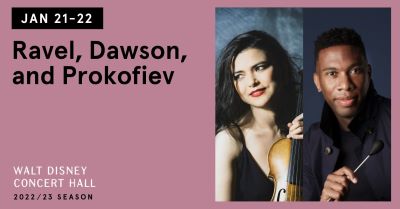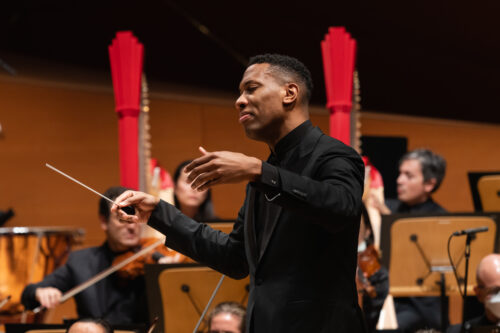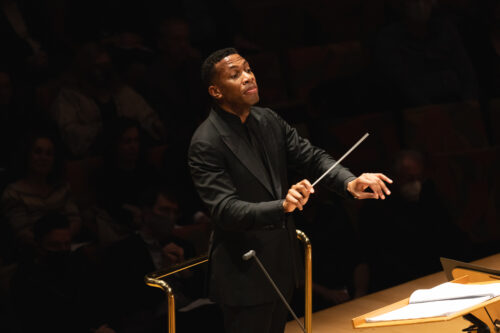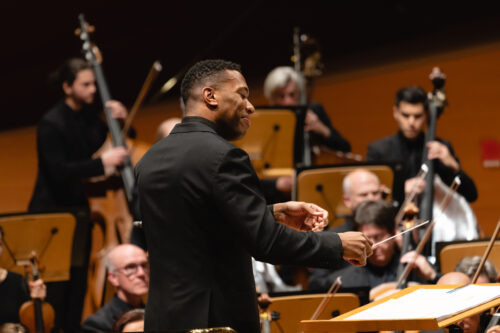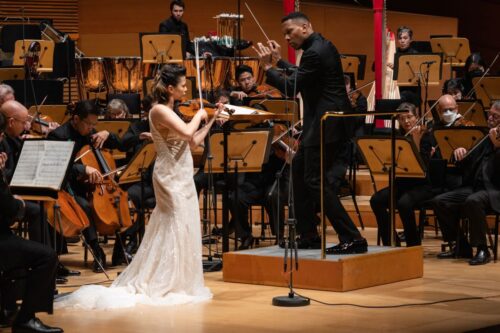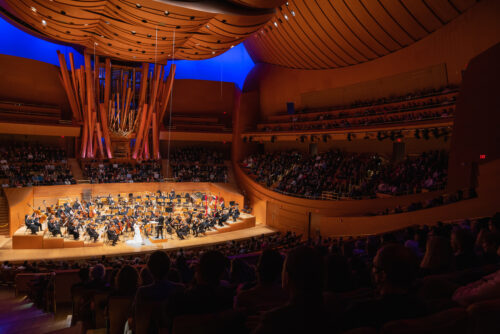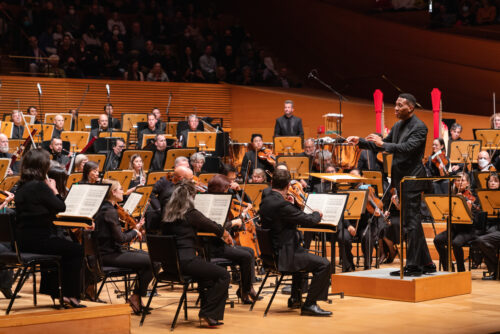DAWSON GETS HIS DUE IN LA PHIL’S FIRST
PERFORMANCE OF HIS NEGRO FOLK SYMPHONY
The swellegant Maestro Roderick Cox returned to Disney Hall with the LA Phil last weekend. Even knowing the talent of the conductor, players, and guest violinist Karen Gomyo, there were some surprises at this stupendous program. The first came before the concert Sunday afternoon, when Cox came to the podium and spoke to the house, acknowledging the senseless mass shooting of 11 elderly ballroom dancers that occurred in neighboring Monterey Park after the previous evening’s performance. He asked for a long silence of mourning, and the very full house did just that. I closed my eyes, and it was quite remarkable to feel grief shoot through so many people, given that it’s getting tougher and tougher to mourn so many mass murders (another occurred in Half Moon Bay just this afternoon).
The silence was broken by the plaintive, haunting horn of Andrew Bain introducing the sweet melody of Ravel’s Pavane pour une infante défunte. According to Ravel, the title has nothing to do with lamenting the dead. Rather, it is a tribute to the actual stately dance, the pavane. But how chilling that Cox’s announcement should lead into a piece literally translated as “Pavane for a Dead Child.” The conductor eschewed the slow and plodding versions I’ve heard. Here, it had a good pace, and was very fluid and regal. Cox conducted almost like an eagle flapping its wings in slow motion. As he has proved before and during this concert, the new principal harpist Emmanuel Ceysson is the finest I have ever heard; he exhibits incredible volume, precision and power with warmth and emotion.
Validating his wonder as a leader, Cox — who is still a guest conductor and not attached to any one organization — then refrained from a break again, moving directly into William Dawson‘s rarely played 1934 Negro Folk Symphony, revised in 1952 with added African rhythms inspired by the composer’s trip to West Africa. Prior to writing this — his masterwork — Dawson had composed gorgeous arrangements of African-American spirituals, which he preferred to call “folksongs.” Just as Dvořák infused his works with folk idioms of his native land — enchanting us with Czech, Moravian and other Slavic melodies — Dawson’s three movements are rife with his own distinctive mastery and development of themes. His goal, he said, was for audiences to know that it was “unmistakably not the work of a white man.”
During the first movement, snippets of folk strains weaved themselves into a driven examination of each tune, with plenty of brass used as declaration. During this, Cox is fierce, breaking a sweat while thrusting his baton towards players. What an exquisite conductor to watch! He’s serious yet gracious and strong yet generous. Concertmaster Nathan Cole played a heartbreaking solo on the violin; Robert deMaine offered a triumphantly singing solo on cello, and Ceysson’s arpeggios thrilled. The second movement has stunning rhythms from a mighty percussion section: Chimes, bass drum, cymbals and timpani were all employed for drama. Instead of ending with a bang, the insistent beat of the drum — almost Native American in nature — simply fades away into the third movement, which is quite filmic, a sound right between March King John Philip Sousa and movie composer Max Steiner. Here, Cox is stately and elegant as some themes sounded like late nineteenth-century dance themes. This is LA Phil’s first performance and my first time hearing the Symphony, but I wasn’t the only one blown away. The patrons erupted into thunderous cheers. It’s far too late, but welcome to the repertoire, Mr. Dawson.
After the interval came Prokofiev’s Violin Concerto No. 1, which premiered 100 years ago in France. As with his piano concertos, Prokofiev’s violin concertos are fiendishly difficult beasts to play (the first movement slightly easier than the others). While the technical and musical masteries of Prokofiev are very apparent in this dazzling work, I never really took to this composer’s violin concerto until I saw it live. I even had missed a romantic, dark melody until I heard Karen Gomyo‘s assured and crisp performance. She can be positively feral and ferocious, even when executing plucks and strikes. With this concerto, it is very important (more so than other violin concertos) to know what’s going on in the orchestra, which she did splendidly. Unfortunately, the set-up of the chamber orchestra had players spread out among empty chairs, so she faced Cox the entire time, and we lost volume with her back turned to us, and the reeds, especially, were overpowering her at times. While it seemed unbalanced from my seat, it was a kick-ass performance. (To be fair to the arrangement of musicians, there were mics everywhere, which makes me suspect this program was being recorded.)
Then it was back to Ravel for the closer. You know you’re in for a treat when over 100 players come on stage. In 1909, impresario Serge Diaghilev commissioned Maurice Ravel to write a score for a new ballet which would be based on the ancient Greek tale of Daphne and Chloe. At nearly an hour, the three-part ballet, one of Ravel’s most voluptuous, would become his longest work. Characterized by the quintessentially Ravelian union of vigorous rhythmic diversity, motoric energy, and refined lyricism, this is an ideal composition to see live at Disney Hall.
Soon after the ballet’s premiere, Ravel published two Daphnis et Chloé concert suites derived from the original score; yesterday’s program contained the far more frequently performed Suite No. 2, a symphonic fragment taken from the Third Scene of the ballet, consisting of “Lever du jour” (“Daybreak”), “Pantomime,” and “Danse generale.” Played without a break, Maestro Cox highlighted every thread in Ravel’s luscious tapestry of sound. Ravel created sparklingly brilliant orchestrations, a perfectly kaleidoscopic score to showcase all of the LA Phil players, but there was a standout with the sub flutist Marley Eder; he had amazing breath control and commanded the long lyrical lines with nuance and imagination, and he flawlessly executed the running scales. Also notable were Burt Hara (clarinet) and Sarah Jackson (piccolo) but all the reeds were exemplary. Thank you Roderick Cox for this blazing-hot Ravel.
photos by Farah Sosa/LA Phil
